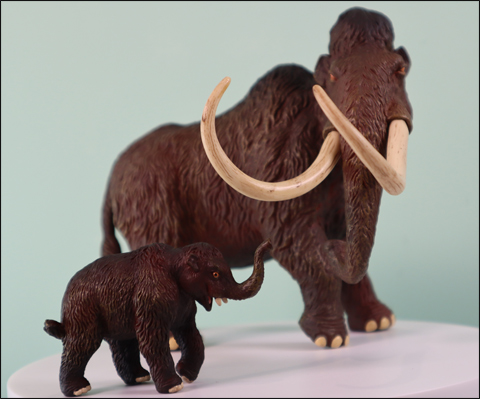Woolly Mammoths on Popular Breakfast Show
Woolly Mammoths on Breakfast Radio
Sunday morning, after a fairly quite Saturday, not my favourite time of the week. Get the papers, have breakfast sort out one or two things to do with the business (but nothing too taxing, it is the weekend after all). Trouble with running your own company is that you never switch off. I am always thinking about Everything Dinosaur and what we should be doing to improve sales, develop new products and such like. You don’t really get any time off, unlike when I worked a “normal” 9-5 job with a salary.
Surprising how often prehistoric animals get a mention in the media. Take for example this mornings breakfast programme on Radio 5 Live. Richard Bacon (the host) had invited listeners to text/e-mail in with their stories about food that they have kept which was well past its sell by date. A fairly mundane and trivial item for a national radio programme. However, we were listening. Actually, to be perfectly honest Sue and I have a digital alarm clock. Everyday at 6.30am it goes off and Radio 5 comes on. I have lost the instructions on how to tune it and I don’t know how to adjust the alarm time for the weekends so we are faced with a choice – either have the alarm go off at 6.30am seven days a week and listen to Radio 5 or don’t use the alarm at all. We could always revert back to my old battery operated alarm clock, but then I would lie awake at night wondering if the battery would last and whether it would work at all. If we had a powercut then the radio alarm wouldn’t work either but if this were to happen at least Sue would have a plausible excuse for arriving late at work.
Anyway, back to the frozen Mammoths…
One of Radio 5’s listeners contacted the station recalling that their old geography teacher had regaled them with stories of Russians dining on Woolly Mammoths as they thawed out of the perma-frost in Siberia. If locals were eating de-frosted Woolly Mammoths then this would be an extreme case of food being consumed well past its sell by date.
I have heard stories too, many text books contain references but to the best of my knowledge I am not aware of any proven cases of people eating recently thawed Mammoths.
There are a number of stories of this nature in circulation. Many Siberian Mammoths that died in the Autumn have been preserved exceptionally well as they have been quickly frozen by the rapid onset of winter and the resulting plummeting temperatures. Even though the animal may have died over 20,000 years ago, the deep freeze that is Siberia has led to some remarkable states of preservation.
Natives were aware of the existience of strange creatures in the ground, but with no knowledge of palaeontology or of elephants Mammoths were thought to be giant moles that burrowed deep underground and perished instantly if they ever broke the surface. This didn’t stop a brisk trade in Mammoth ivory recovered from the carcases. Local warlords and leaders did try to put a stop to this by spreading rumours that the corpses were cursed and that if you interfered with one you would have bad luck. Stories from the late 18th Century of a Tungus native who had allegedly removed a single tusk from a Mammoth corpse and within a few years he and his family and died, certainly helped protect the precious ivory.
There is not much evidence of people actually consuming thawed out Mammoth, but as these animals are eroded out in spring thaws they begin to defrost and many of the corpses have been reported as having been attacked by local scavangers and dogs.
Woolly Mammoths
In the notes of the 1901 expedition to Siberia in search of Mammoth remains led by the eminent zoologists Otto Herz and Eugen Pfizenmayer it is claimed that they were able to remove about 130 kilograms of meat from the hindquarters of a de-frosting Mammoth carcase. The meat was so well preserved that the expeditions dogs eagerly ate it, but the scientists themselves although tempted did not try it as it smelt like “a badly kept stable heavily blended with the smell of offal” as Pfizenmayer recalled.
I think you would have to be pretty desperate to attempt to eat Woolly Mammoth, our ancesters certainly hunted these creatures but they would have been eating fresh meat, not the remains of an animal preserved frozen for thousands of years.
An Adult Woolly Mammoth Model with a Juvenile

The CollectA Deluxe Woolly Mammoth model in 1:20 scale and the CollectA Prehistoric Life Woolly Mammoth calf. Picture credit: Everything Dinosaur.
Picture credit: Everything Dinosaur
Several Mammoth Species
There are a number of Mammoth species known, the largest was the Columbian (M. columbi) of North America with males weighing up to 10 Tonnes and standing over 3.5 metres high at the shoulder. The Woolly Mammoth (M. primigenius) was slightly smaller with much denser fur, believed to be a dark brown to sandy colour. Mammoths were very symbolic to our early ancestors with many cave paintings depicting them and hunting scenes.
Woolly Mammoths are still very popular with children today “Martha the Mammoth” was a popular animal on the recent Prehistoric Park TV show and Mammoths come out quite high in our surveys.
Some good models around too, such as the adult Woolly Mammoth models and baby Woolly Mammoth toys.
Everything Dinosaur Models: Dinosaur Models and Dinosaur Toys.

